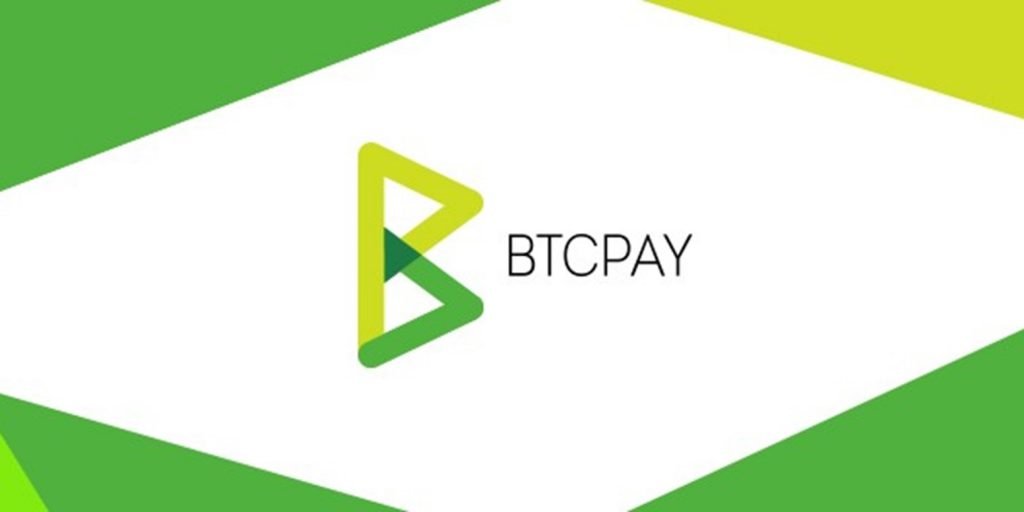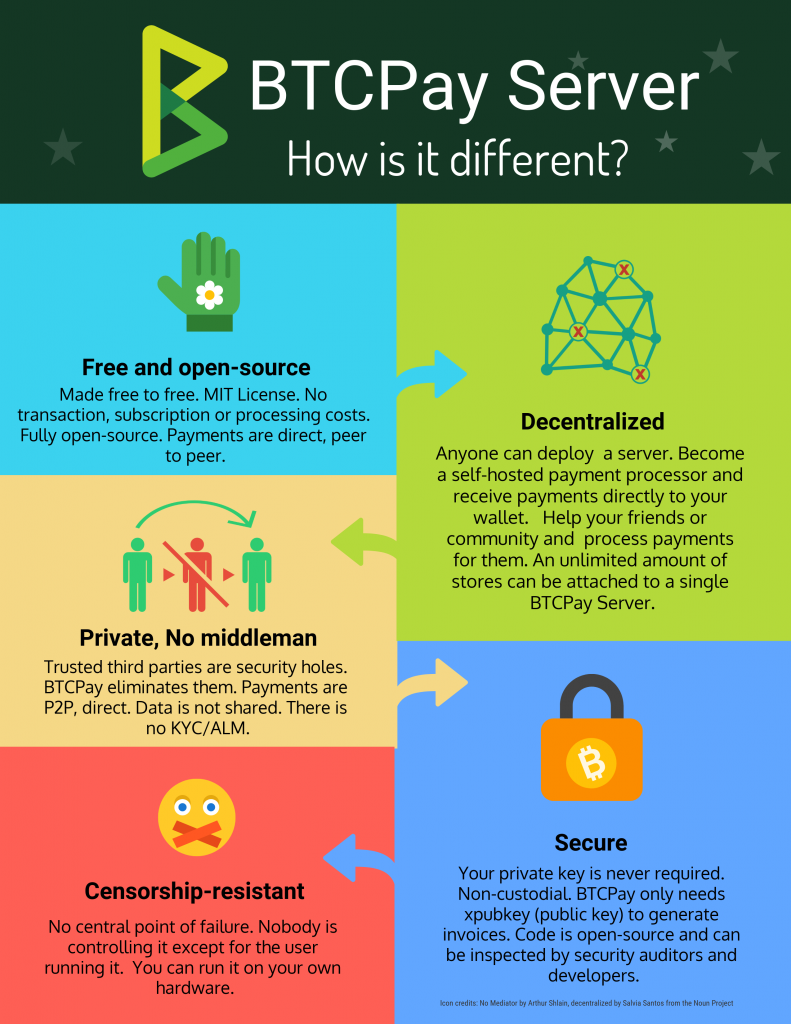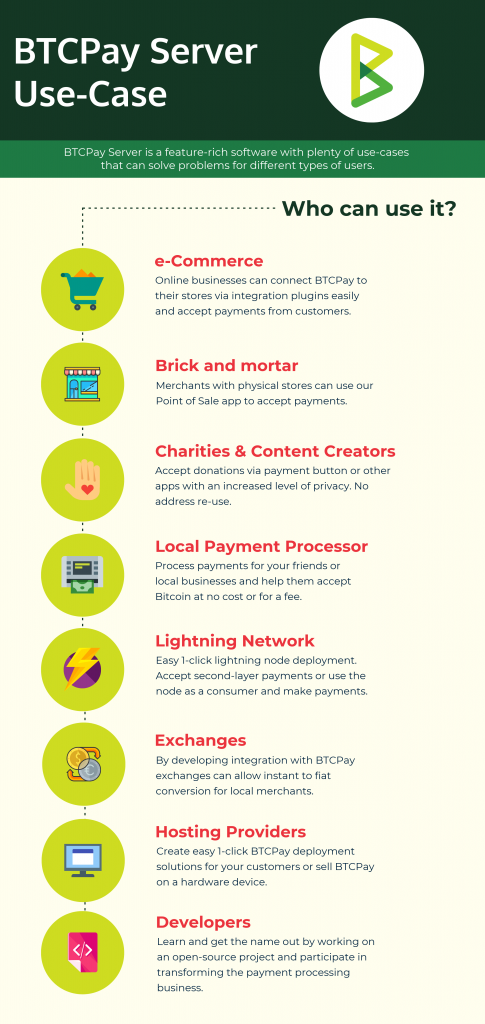
This post is part 2 in a series on BTCPay Server.
Here is Part 1
In part 1, we spoke with Pavlenex, of Bitcoinshirt.co, who was kind enough to detail his first-hand experience using BTCPay Server for his Bitcoin T-shirt business.
In this article, we will be taking a look a much closer look at BTCPay itself.
BTCPay is a server that runs open source software that lets you become your own payment processor for Bitcoin payments. You’re basically like a Bitcoin version of Paypal. As a merchant, this gives you tremendous power, privacy, and control of how you accept Bitcoin for goods and services.

Ok, so now that we know what BTCPay is, let’s get to why you’d want to use it over a custodial payments platform like Coinbase, Bitpay, or Coingate. Yes, these platforms allow you to securely accept Bitcoin payments, but it comes at a price.
Sure they charge fees, but that is only part of what they take from you. They also take away your financial freedom, requiring intrusive levels of personal information stripping you of privacy, for AML/KYC. They will report any transaction they arbitrarily deem suspicious and suspend or freeze your account blocking access to your funds. They impose their morality upon your purchasing habits by blocking people who use online gambling sites or other adult content sites. Many have even deplatformed a variety of people and businesses for political reasons.
BitPay and Coinbase in particular, have a nasty habit of undermining the Bitcoin network, supporting contentious forks, promoting
The problem is so bad that platforms like Mastodon, Diaspora, Peertube, BTCPay, LibrePatron, and BitPatron have sprung up, to meet the needs of users who demand freedom of speech, and those who have already been

Besides the obvious political
If you’re like me, you’re probably getting sick of all this censorship and
It is my view that money should be neutral and apolitical. I should be able to spend my money any way I see fit, without interference, as long as I am not injuring someone else or their property. Another shortcoming is access to these platforms for underbanked populations, outside of Western countries who are simply excluded altogether.
The beauty of BTCPay is that it lets you just sidestep all that BS, and reclaim your financial sovereignty.
Since you are your own payment processor, using your own node to verify transactions on the immutable Bitcoin blockchain, using a censorship-resistant form of sound money, there is little anyone can do to stop you,

How to get started
Now that we have the what and why out of the way, let’s take a look at how to get up and running with BTCPay Server. There are two basic ways to get started. The hard way and the easy way.
The hard way is manually installing BTCPay, while the easy way utilizes an automatic launcher that does all the setup work for you, and only requires a couple of clicks to get you up and running. There are also Google cloud and Docker deployment, and Raspberry Pi options.
Here is some useful information to help you decide your deployment method.
The hard way (manual install)
I am not really going to cover this method in depth. There are a number of good tutorials that cover it a lot better than I could. Here is a good one:
Freedom Node BTCPay Server manual install tutorial
The easy way (automatic launcher)
There are two ways to deploy a BTCPay server in one-click. You can do it with Microsoft Azure, or Luna Node.
Azure Deployment
Microsoft Azure is little more expensive from what I have read, (Never used it!). This article states that the costs are around $65/month, but that you can prune your node and get the costs down to around $20/month.
Here’s the guide to lower costs of Azure BTCPay deployment.
If you want to go with Azure, here is a link to the one-click installer
Luna Node Deployment
Luna Node was the method used for this website. It’s cheaper and just as easy to deploy as the Azure one-click install (two clicks, instead of one). You can get up and running with a pruned node for as little as $8.80/month with the M2 plan according to this article.
My experience with Luna Node has been excellent. Favyen the guy who handles the support tickets has the patience of a saint. He has gone above and beyond the call of duty to assist me with any issue I have had.
To go with Luna Node, create an account, and follow these instructions borrowed from the article above:
Go to BTCPay Server launcher on LunaNode — https://launchbtcpay.lunanode.com
Paste your API key and API ID.
Click Continue
Use generated LunaNode domain or use your own (see this guide for using your domain)
Click Continue
Customize BTCPay according to your needs (add SSH key, SSL e-mail, altcoins, Lightning Network implementation, etc.). Note: If you’re using more than two altcoins, go with a better hosting plan.
Launch BTCPay
Wait for 5 minutes for the server to deploy. Be patient.
Go to your domain.
from “Launch BTCPay Server via web-interface and deploy Full Bitcoin Node + LND…
… in less than a minute, for less than $10/month”
Here is an affiliate link you can use to support our site and sign up for Luna Node at the same time.
Here is a link to the Luna Node two-click launcher
Lightning Network integration with BTCPay
When you set up your BTCPay server, you can elect to include a Lightning Network node to be created along with the Bitcoin full-node it creates. This allows you to send and receive second layer, off-chain lightning network transactions.
BTCPay works with both the C-Lightning and LND Lightning Network implementations, and even integrates with Spark wallet (C-lightning) and Zap Wallet (LND).
I’m not sure which implementation is more popular, but on my BTCPay Server, I chose to use LND. I chose it for no other reason than because I like Zap wallet.
E-Commerce Plugins and Integrations
BTCPay has a number of integrations for popular open source e-commerce platforms. Chances are, that if you run an e-commerce site with open source software, BTCPay has an existing integration with your chosen platform. The resources below will help you get your desired platform installed and paired with your store.
Woocommerce
Woocommerce is one of the most popular platforms for e-commerce. It is the e-commerce plugin for the WordPress content management system (CMS). It is estimated that 42% of e-commerce sites use Woocommerce.
Here’s a link to get started with WordPress.
Here’s a link to get started with Woocommerce.
Here is the Woocommerce documentation.
Here is a link to the BTCPay documentation for Woocommerce.
Here are links to two excellent tutorials to get you started:
How to Create an Online Store & Accept Bitcoin – Step By Step Guide
Drupal
Drupal is another really popular open source CMS commonly used for e-commerce sites. It is estimated that 2.3% of all websites use Drupal.
Here’s a link to the Drupal Commerce install guide.
Here’s the link to the BTCPay documentation for Drupal.
Here’s the link the Commerce BTCPay Drupal plugin.
Here’s a link to a video showing how to configure Drupal for BTCPay.
Here’s a link to a Drupal demo store with BTCPay integration.
Magento
Magento is an open source e-commerce platform from Adobe which is written in PHP. It was originally developed by Varien, Inc. The Magento BTCPay integration has not been extensively tested, so a word of warning, it may be buggy.
Here’s a link to get started with Magento.
Here’s a link to the BTCPay documentation for Magento.
Here’s a link to the Magento plugin for BTCPay.
Here’s a link the Magento Quickstart guide for the BTCPay Plugin.
Here’s a link to the Magento Community Support Forums.
PrestaShop
PrestaShop is another popular e-commerce platform. PrestaShop’s BTCPay integration is a Beta version, so use it at your own risk.
PrestaShop is a freemium, open source e-commerce solution. The software is published under the Open Software License (OSL). It is written in the PHP programming language with support for the MySQL database management system.
PrestaShop is currently used by 250,000 shops worldwide and is available in 60 different languages
PrestaShop Wikipedia
Here’s a link to get started with PrestaShop.
Here’s a link to the PrestaShop documentation.
Here’s a link to the PrestaShop support forums.
Here’s a link to the PrestaShop BTCPay documentation.
Here’s a link to the PrestaShop BTCPay plugin.
Here’s a link to the BTCPay server BitPay client (needed for PrestaShop).
Custom Integration
The custom integration requires advanced knowledge of web development but if that’s your cup o’ tea, feel free to give it a try.
Here’s a link the BTCPay documentation for custom integrations.
BTCPay Wallet Support
BTCPay has an internal wallet that integrates with the Ledger Nano S hardware wallet. It’s not a hot wallet, because your keys stay on your Nano S.
If you need a Ledger Nano S, you can pick one up direct from Ledger, through our shop and support both Ledger and our site.
Besides its support for Ledger Nano S, BTCPay also supports a variety of external wallets. Here is the list of recommendations from the BTCPay Wallet FAQ:
- Electrum - desktop wallet
- Ledger Nano S - hardware wallet (other hardware wallets should be added at some point)
- Zap - Lightning Network LND wallet
- Spark - Lightning Network c-lightning wallet
- Sentinel - Watch-only on-chain wallet Android
- ArcBit / bitWallet - Watch-only on-chain wallet Android
Here’s a link to a video showing you how to connect your wallet to your BTCPay Server.
This concludes part 2
This section of our series on BTCPay covers the meat and potatoes of the system itself. The resources listed above should be enough to get you rocking and rolling as your own payment processor and accepting Bitcoin payments for your e-commerce site.
You’re now ready to take back your financial sovereignty by being your own bank and payment processor.
In part 3 we will be reviewing some of BTCPay’s apps and features which highlight and add to its versatility. BTCPay is truly a game-changer for e-commerce. As the old way of doing things becomes more restrictive and less useful we will see the future of online shopping move in this direction of decentralization. Commerce will take the path of least resistance and friction.
If you found this article entertaining or useful, and feel led to support
0 Comments